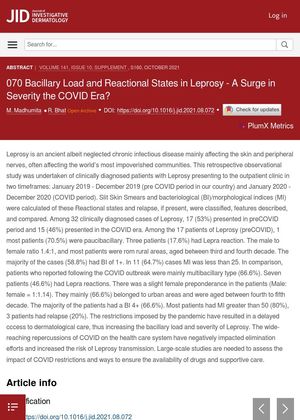Bacillary Load and Reactional States in Leprosy: A Surge in Severity During the COVID Era?
October 2021
in “
Journal of Investigative Dermatology
”

TLDR The COVID-19 pandemic has led to more severe cases of Leprosy due to delayed medical care.
This retrospective observational study compared 32 clinically diagnosed cases of Leprosy before and during the COVID-19 pandemic. Of these, 17 cases were pre-COVID, with 70.5% being paucibacillary and 17.6% having Lepra reactions. The majority of these patients were from rural areas, aged between their third and fourth decade, and had a bacteriological index (BI) of 1+. In contrast, during the COVID period, 15 cases were reported, with 66.6% being multibacillary and 46.6% having Lepra reactions. These patients were mainly from urban areas, aged between their fourth and fifth decade, and had a BI of 4+. The study concluded that the pandemic restrictions have delayed access to dermatological care, increasing the bacillary load and severity of Leprosy. The impact of COVID-19 on the healthcare system has negatively affected elimination efforts and increased the risk of Leprosy transmission. Further large-scale studies are needed to assess the impact of COVID restrictions and ways to ensure the availability of drugs and supportive care.




